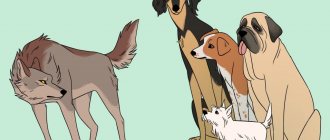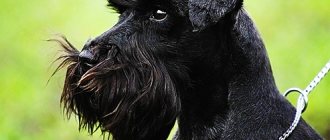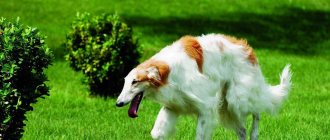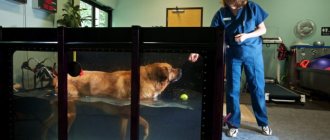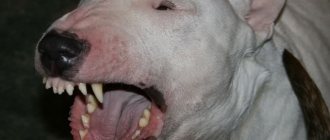At the moment, there are many commands for dogs. Some of them can begin to be learned at the age of 2-3 months, while for others you need to master basic skills. When studying the art of training, you need to decide what level of training you expect from your pet. Everything else will depend directly on you. For example, raising a dog can be influenced by how well you were able to find a common language with it. Therefore, next we will look at how to teach a dog to walk on its hind legs, and also find out what dog trainers advise pet owners.
Variety of commands and benefits of training
It is interesting that teams can be both basic and more complex - special and circus. All dogs are trained first, from the Papillon to the Moscow Guard. These are the skills “near”, “lie down”, “sit”, “to me”, “voice” and others. Accordingly, when studying such commands, you need to understand that this is not only the dog fulfilling your requests. In fact, any training and education contributes to the development of discipline, the ability to listen and interact with the owner. Training a team to walk on its hind legs belongs to the group of circus skills. Along with them, there are special ones that are trained for service or hunting dogs. Thus, all commands are subordinated to a specific goal. This means that the owner can decide how he will interact with the pet and what to teach him.
Teaching commands is very useful for dogs; it develops skills in interacting with the owner, and also develops obedience. The dog happily and proudly follows the instructions of the person. But here it is also important to know in what situations stubbornness can manifest itself. Some breeds have this character trait. So, the Pekingese will not be trained like the Papillon. In any case, when a dog is trained to master commands, strong-willed qualities develop. This category should include such things as endurance, the ability to listen to the owner and not succumb to the influence of extraneous distracting sounds.
Do you want your dog to be obedient? Order a walk with elements of training!
Find out more
submit your application
Algorithm for learning to walk on hind legs
Considering the step-by-step execution of the command “walk on your hind legs,” you need to decide on an algorithm for learning the skill. There are several ways to train dogs. You can start walking immediately or first master the initial “bunny” or “serve” position. In the second case, the dog will understand how to maintain balance. You will have to practice a little in this, because for any dog an unnatural pose can be difficult at first.
When starting to teach the “bunny” or “serve” command, adhere to the following sequence:
- From the initial “sit” position, the dog is given the “serve” command. At the same time, lift the pet by the body and lean it against a wall or any other support. You can stand behind the dog and help him rise, leaning on your legs;
- Owners know that when training dogs they need to use treats as rewards. Therefore, to teach your dog to walk on its hind legs, stock up on small pieces of meat, sausage, or special food from the store. Manufacturers also produce various treats designed specifically for training. But you can also use one taken from home;
- Training occurs in stages. First you need to let the dog stand for a couple of minutes and then praise him. Not a single dog can successfully execute a command right away. It may take about a month or two before the dog learns to hold his back;
- A very young child with an immature musculoskeletal system should not start learning this command. Wait a little until your pet gets stronger, and only then start training.
Everything else is simple. You need to use a treat that is held over your pet's head. This will keep the dog moving forward. Praise every step. First, you can help the dog by supporting him under his front paws. There are several main stages in teaching dogs to walk on their hind legs. By adhering to a certain algorithm and being patient, it is easier to achieve excellent results.
If you train using a clicker, the command is not entered immediately. Only after the dog has formed a habit should you add a stimulus word. It is easy to teach dogs to walk with a treat, but then you need to gradually remove the reward. For example, raise your hand, give the dog the opportunity to stand on its hind legs, and only after returning to the “lying down” position, feed it.
Spinal injury
The first thing to assume if a dog lacks physical activity is a spinal injury. Damage occurs from a fall from a height, a car accident, or an attack by other dogs or animals. The owner is powerless with such a pathology - the dog must be provided with qualified assistance. The pet should be quickly taken to the veterinary clinic, having first secured it on a hard surface so that it does not change position during movement, as this will cause repeated injuries.
Determining the severity of injury - additional diagnostics
The veterinarian first conducts a clinical examination of the pet to identify life-threatening conditions for the dog - internal bleeding, organ ruptures, violation of the integrity of cavities. Subsequent studies (special neurological) are carried out only after emergency situations that threaten the patient’s life have been eliminated, or in their absence - less than 30% of dogs with spinal injuries do not have concomitant pathologies.
Types of vertebral damage:
- compression fracture of the vertebral body;
- destruction of articular processes;
- dislocation, displacement of the vertebrae;
- transverse fracture.
A complete neurological examination of the dog is carried out to determine the location of the pathological process and its type. In sick animals, there are several types of disorders - motor disorders, reflex disorders, loss of sensitivity. The dog’s ability to move is determined at the stage of collecting an anamnesis (the data is clarified from the owner) and the initial examination - the animal should be called and the reaction of the limbs and tail should be observed.
The most important diagnostic sign is the preservation of pain sensitivity in the pelvic limbs . If there is no pain reaction when squeezing the fingers with tweezers, then this is an unfavorable symptom. It is important to distinguish between a reflexive jerk and a pain reaction. In the first case, when the finger is touched, the dog jerks its leg, in the second, it turns its head, squeals, and tries to run away or bite the diagnostician.
Testing of pain sensitivity should only be carried out on dogs in a calm state. Usually the pain reaction is expressed - turning the head, raising the voice. But if the animal is in serious condition, then the changes may be unnoticeable - the pulse and breathing quicken, the pupil dilates.
Next, you need to take an x-ray to determine the location and extent of the damage. More often, the dog has a vertebral fracture or dislocation. It is worth noting that the more caudal the location of the pathological process is, the higher the chances of recovery. A complete blood count is also performed.
Plain radiography determines the condition of the spine. This method can estimate the size of the deformation in two planes. The condition of the tissues surrounding the spine is also determined. Assessing bone damage can be done using a CT scan, but this method cannot detect changes in soft structures.
Magnetic resonance imaging is more informative. It is possible to visualize the arachnoid and epidural spaces of the spinal cord. The condition of the spinal cord and intervertebral discs is determined. Only this method can detect changes in the blood supply to the spinal column.
The clinical picture of spinal cord injury varies depending on time:
- in the acute form, the picture of shock predominates (severe depression, stuporous state), lasting up to 2-3 days;
- in the next 2-3 weeks, the dog experiences a complete loss of motor activity caused by damage to the brain and membranes, swelling and inflammation at the site of injury;
- An intermediate period may last up to 3 months, characterized by the appearance of the true picture - impaired mobility, pain reaction, lameness;
- the late period lasts up to 2 years, at which time the nervous system develops and spinal deformity appears.
Emergency care and treatment
Spinal damage is a very serious disease. Only in 10-12% of cases of vertebral fractures is recovery observed. In case of pathologies of the intervertebral discs (even in the absence of pain sensitivity), the chance of recovery is 60-70%. The surgery is performed by a specialist in spinal surgery. Therapy for mild spinal pathology can be medicinal (conservative); for severe damage, surgical intervention is necessary. The decision to choose treatment is based on the diagnosis of the patient. Indications for surgery:
- deformation of the structure of the spinal canal, identified x-ray;
- introduction of bones and other tissues into the spinal cord canal;
- disturbance of blood supply, cerebrospinal fluid patency;
- severe dysfunction of the spinal cord;
- cardiac, respiratory failure.
First of all, the mobility of the spinal cord should be limited to avoid repeated injuries. This must be done to transport the dog. Often, immobilization in combination with drug therapy is enough to recover the pet and restore all its functions.
Most often, fractures and dislocations are recorded in dogs in the lumbar region, as well as in the last thoracic vertebrae. The first step is to relieve compression of the spinal cord, restoring the diameter of the canal. Several surgical techniques have been developed:
- fastening the spinous processes with a pair of plates located on the sides of them. At least 3 vertebrae should be captured in each direction from the damaged area;
- fastening the vertebral body with plates placed dorsal to the transverse processes;
- the dislocation is eliminated using a pair of Kirschner wires inserted into the vertebral body;
- The seventh lumbar vertebra is attached to the sacrum.
Conservative therapy attempts to eliminate the pain reaction, speed up the recovery process and reduce the chances of complications. Motor activity can return to the dog if more than 5% of the spinal cord pathways are restored. Therefore, preventing complications seriously increases the chances of your pet’s recovery. A big role is given to maintaining a normal level of blood pressure, the content of proteins and salts in the plasma - it is necessary to perform intravenous infusions of substitutes (polyglucin, hemodez).
Painkillers should be used cautiously. On the one hand, eliminating the pain reaction is necessary for the dog’s normal functioning and speedy recovery. But there is a sharp increase in secondary injuries when pain is relieved - dogs increase activity, try to remove the bandage and injure themselves.
The use of glucocorticoids is indicated at an early stage of the disease. Their main effect is to prevent the development of the pathological process. There is also an acceleration in functional recovery. But in dogs in the late stages of spinal cord injury, there is no therapeutic effect.
The best medicine that shows high efficiency is methylprednisolone succinate, which causes a significant increase in motor activity. But when it is used in dogs, perforation of the gastrointestinal tract, sepsis, and pneumonia are often observed, especially when used simultaneously with other glucocorticoids.
What walking options are there?
Your pet can be taught not just walking, but more complex tricks. They are “waltz” and “dance”. The difference between the commands is that in the first version the dog stands on the owner’s feet and moves with him. When dancing, the dog repeats the trajectory of your movements. When learning, you need to choose which command you will study. This will prevent your dog from getting confused. To begin with, of course, you should make sure that the dog follows the command to walk on its hind legs well and maintains balance.
Do you have a special situation?
Our specialists met with everyone. They share their experiences in detail in our online school!
more details
You can use different variations of the exercise:
- Rotation around an axis. Teach the dog from the starting “waltz” position, gradually turning around you. The dog stands on your feet;
- Learning to jump on the hind legs. In this case, you should make sure that your pet’s musculoskeletal system is fine. To do this trick, use the "up" command;
- Waltz behind the owner's back as a variation of the "polonaise" trick.
Symptoms and Warning Signs of Lower Leg Weakness in Dogs
Depending on the severity and underlying cause of the problem, rear leg weakness can cause:
- Pain in hind legs
- Stiffness in joints and legs
- Weakness/restlessness in hind legs
- Lack of coordination
- instability
- Abnormal gait
- Reluctance to be active
- Swelling around the hind legs
- incontinence
Other symptoms are possible, but these are the most common.
Symptoms also depend on the underlying cause of the problem, as well as the age of the dog.
Some joint weakness may simply be a normal sign of aging. But if there is sudden weakness in the dog, then veterinary help must be sought immediately.
Finding interaction with your pet
In the owner-pet dyad, there are several important factors that ensure understanding. This is respect, trust and obedience. What is needed for the dog to begin to obey you and follow the training program? Whatever command the dog learns, interaction with the owner always comes to the fore. This process is influenced by communication, which began to develop from the first day the animal appeared in the house, its inclinations, character and upbringing measures. Perhaps not every dog will immediately show obedience. To achieve your goal, make the dog feel respect for you and see the owner as a leader. Show patience and a strict but not harsh attitude. When your pet feels the confidence and firmness in your voice, the likelihood of good parenting increases.
How to correctly determine the cause of lameness
Regardless of the degree of lameness, the cause is determined by careful examination of the problem limb. If you cannot identify the disease on your own, you should contact a veterinary clinic. You will also have to go to the hospital if a serious pathology is detected.
On a note. When examining the paw, you must carefully monitor the animal's reaction.
The following symptoms indicate the severity of the problem:
- the dog tries to tuck his paw when walking;
- cannot fully lean on a limb;
- decreased activity;
- The dog has stopped jumping and cannot go up or down stairs.
In this case, the paw may not hurt at all.
At the clinic, the doctor carefully examines the dog, collects anamnesis and, based on the results, prescribes a surgical and neurological examination. Further, X-rays, MRI, ultrasound, computed tomography, arthroscopy may be required.
Features of home diagnostics
If the dog’s previously light and springy gait suddenly changes for the worse, it’s easy to notice. There is an effective way to check the condition of the pet: wet the surface and walk the dog along it, then analyze the step by measuring the distance between the tracks. It is also necessary to pay attention to the position of the paws. Signs of problems indicate:
- short step;
- extension of the limb or rotation inward;
- if the leg is sick, then the mark will be weak.
For further diagnosis, the dog is taken to the veterinary clinic.
Training rules
Maintaining a respectful and trusting attitude is very important. But you should also develop an attitude towards training. Dog handlers advise during training:
- Practice executing commands daily. In this case, you need to pay attention to a specific skill. This way you can rationally distribute the load and prevent your dog from getting tired;
- When teaching a dog to walk on its hind legs, you have to divide the team into several component stages. Gradually practice performing individual steps, complicate the command;
- Training can take place in a place where there are no distractions. These could be foreign dogs, people, vehicles. After your pet has mastered the skill, you can try walking in another area. Before this, it is important to ensure that the dog does not get lost in the presence of extraneous noise;
- When walking your dog, take a reward with you. Based on your pet's preferences;
- The command is given in a strict tone, but praise needs to be more gentle.
Treatment Options for Weak Dog Legs
Treatment for dog leg weakness can vary greatly depending on the underlying cause of the problem.
Your veterinarian may recommend surgery in severe cases. In other cases, pain relief and gentle exercise may be required.
Medications can help with pain and inflammation, but usually will not completely reverse the problem.
Treatment also depends on the age and health of the dog. If it is a puppy with weak hind legs, treatment recommendations may be more aggressive since the puppy has a long life ahead of him.
If this is an older dog with hind leg weakness, symptoms will usually be managed with medication. More aggressive treatment options (such as surgery) may be available but are not always recommended.
In some cases, veterinarians recommend the use of tools and devices that provide support for dogs with weak hind legs.
Dog braces for weak hind legs can help improve mobility for your pet and keep them active while reducing pressure on the affected area.
